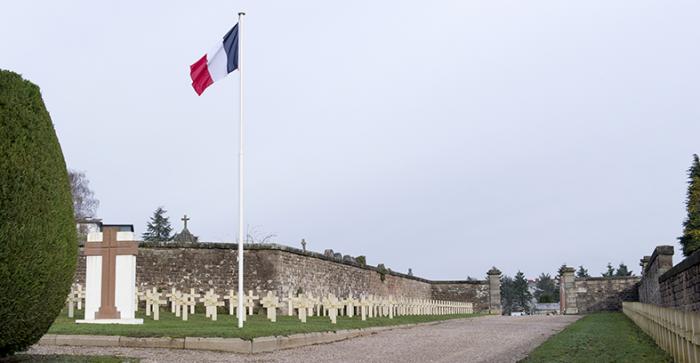
La nécropole nationale d’Épinal. © ECPAD
Pour accéder au panneau d'information de la nécropole, cliquer ici 
The Epinal national cemetery brings together the bodies of 1,307 French soldiers, 881 of whom lie in two ossuaries, 11 Russians and 9 Poles who died in the town hospitals opened during the Great War, as well as 71 Indians who died during the Second World War. Created in order to welcome garrison graves from before the war, this cemetery was successively developed between 1921-1924 then in 1935 in order to bring together the bodies exhumed from temporary military cemeteries.
In 1914, faced with the proximity of the fighting, 14,000 of the 26,000 civilians fled the town. The elderly were moved towards the Haute-Saône, whereas the young orphans were welcomed in Mâcon. In order to ensure the security of the town, non-mobilised men welcomed the populations fleeing the fighting that was taking place in the sector of Raon-l'Etape and Badonviller.
Throughout the whole of the war, this stronghold would be subjected to numerous bombardments and became a town behind the front where warehouses, feed stores and hospitals were set up. These health structures opened in requisitioned buildings, such as numerous barracks, schools or civilian hospitals.
In September 1921 the mayor of Epinal, Augustin Baudouin, asked for his town to be awarded the Croix de Guerre (War Cross): "Located a few kilometres from the line of fire which, at one point, was less than 25 km away, at the junction of numerous railway lines ending at Saint Dié, Nancy, Neufchâteau, Dijon, on the path of the troops going to the front, Epinal did not cease - throughout the duration of the hostilities - to be the enemy's target. (...) Epinal was constantly on alert throughout the hostilities; its inhabitants suffered both personally and materially; more than 250 torpedoes were launched at the town during the course of the fighting, not to mention the bombardments by machine guns and the inevitable accidents due to the defence fire from the square". In October 1921, the town received this honour, as it did in 1939-1945. In 1954, these two decorations were incorporated into the town's coat of arms.
Some of the soldiers buried in this cemetery were Commonwealth troops and came from India. Prisoners-of-war, these men were imprisoned at Frontstalag 315 in Chantraine near to Epinal. On 11 May 1944, an American squadron bombarded the sector. By mistake the barracks, like those of Chantraine, were for the most part destroyed. 500 Hindus died there, whilst over 2,000 left to hide in the forests surrounding Epinal.